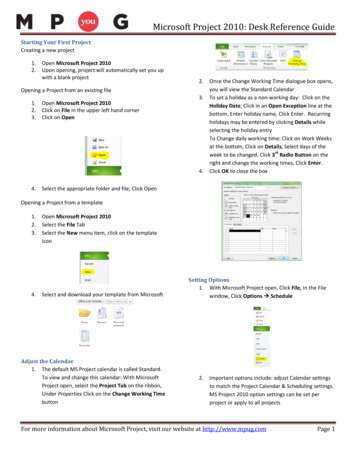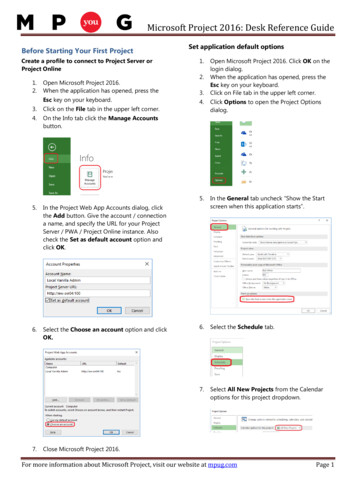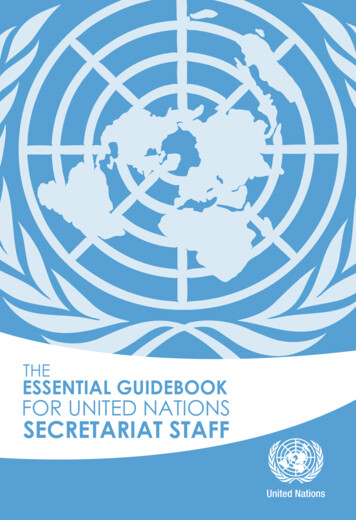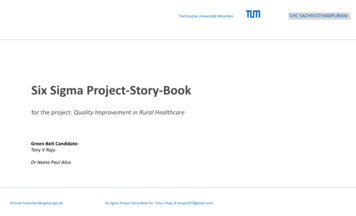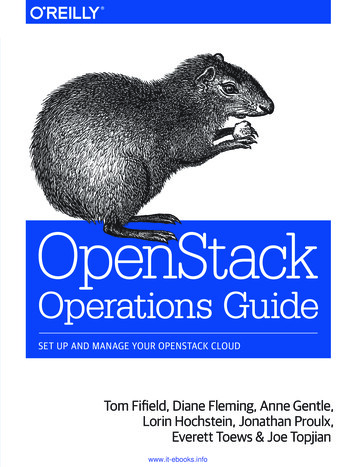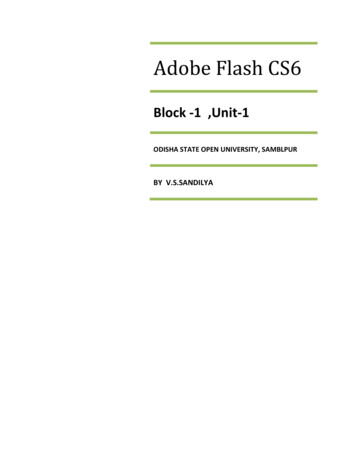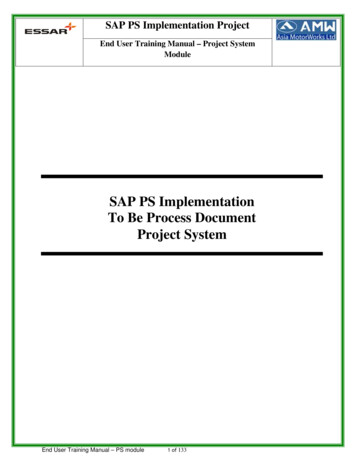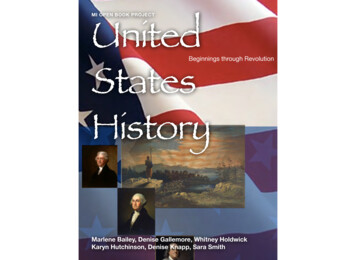
Transcription
UnitedStatesHistoryMI OPEN BOOK PROJECTBeginnings through RevolutionMarlene Bailey, Denise Gallemore, Whitney HoldwickKaryn Hutchinson, Denise Knapp, Sara Smith
United StatesHistory BeginningsthroughRevolution
The text of this book is licensed under a Creative CommonsNonCommercial-ShareAlike (CC-BY-NC-SA) license as part ofMichigan’s participation in the national #GoOpen movement.This is version 1.6 of this resource, released in July of 2016.Information on the latest version and updates are available on the projecthomepage: on-NonCommercial-ShareAlike CC BY-NC-SAii
The Michigan Open BookProjectAbout the Authors - US History - Beginnings through RevolutionMarlene BaileyElk Rapids Public SchoolsLakeland Elementary SchoolMarlene Bailey serves as an elementary social studies chair for the Elk Rapids schooldistrict Curriculum Committee. She holds a bachelor of science degree in Education fromMichigan State University and a graduate degree in Curriculum and Instruction from LouisNational University. Bailey has more than 30 years of classroom experience with at least 20years of teaching fifth grade social studies. Currently part of an International BaccalaureateProject Manager: Dave Johnson,Wexford-Missaukee Intermediate SchoolDistrict5th Grade Team Editor: Susan Laninga,Grand Valley State University5th Grade United States History Beginnings through Revolution Authors:Marlene Bailey, Elk Rapids PublicSchoolsDenise Gallemore, Marysville PublicSchoolsWhitney Holdwick, Harbor Beach PublicSchoolsKaryn Hutchinson, Sault Ste. Marie AreaPublic SchoolsDenise GallemoreMarysville Public SchoolsGardens Elementary SchoolDenise Gallemore has been teaching elementary school for 24 years. She earned herMasters of Teaching Degree from Wayne State University & her undergraduate fromCentral Michigan University. Denise has taught at every grade level but most of hercareer ( 15 years) has been spent in 5th grade. She has taught 5th Grade Social Studiesto all sections at Gardens School, a state-recognized Beating The Odds School as wellas a Michigan Reward School. As well as teaching, Denise serves as a SchoolImprovement Chair, Leadership Team, & works hard at Community Service projects withWhitney HoldwickHarbor Beach Community SchoolsHarbor Beach Middle SchoolWhitney Holdwick earned her Bachelor of Science degree in 2010 from CentralMichigan University with a focus in elementary education. She is currently workingtoward her Master’s degree. Holdwick has worked in the classroom for five years,teaching fifth and sixth graders. She is involved in many school committees and alsospends her time coaching basketball. Apart from teaching, Holdwick enjoys spendingher time with her family, which currently consists of a wonderful husband and adorablelittle boy.
Karyn HutchinsonSault Area Public SchoolsLincoln Elementary SchoolKaryn graduated summa cum laude from Lake Superior State University in 2003, where shereceived her bachelor degree in elementary education. She went on to earn her master’sdegree in curriculum and instruction from Lake Superior State University. This is Karyn’s12th year teaching in Sault Ste. Marie. She has 5 children and lives on Sugar Island with herhusband Tim and her children.Denise KnappWyandotte Public SchoolsWashington ElementaryTeaching is a second career for me. I have been involved in many projects. Through theMichigan Economics Council I was a program presenter and a Crystal Apple recipient forEconomics Education. I have been involved in Class A assessment writing and haveparticipated in the new teacher training committee for writing. Currently teaching 5th grade,but have taught 3rd, 6th, 7th, and 8th grade as well. Masters in Education as an inclusionspecialist. Married for 31 years, two adult children, and one granddaughter.Sara SmithLaker School DistrictLaker Elementary SchoolSara is a fifth grade teacher at Laker Elementary. She graduated from Laker High Schoolin 2007 and from Saginaw Valley State University in 2011. Sara is currently working onher Masters degree through SVSU.She was hired by Lakers in February of 2012 and has been there ever since. She runsseveral clubs for her school including recycling, dance, and underwater robotics.Outside of school, Sara is involved with several activities. She runs her own business andrecently bought a house. Sara spends a lot of her time working on her house and servingon different community boards. In her spare time, you can find Sara reading, playingpiano, or spending time on the beach!
Chapter 1StudyingHistoryQuestions to Guide InquiryWhat is Social Studies?How do Historians study the past?
Section 1What is Social Studies?QUESTIONS TO GUIDE INQUIRY1. What is Social Studies?2. How do historians study the past?“Our greatest glory is not in never falling,but in rising every time we fall.”-ConfuciusWhat is social studies? Think about what it means to be social(interact with individual people and groups) and what it means tostudy something. Put those two thoughts together and you have abasic definition of social studies. It is the study of how peopleinteract with their world, work together, how we use our resources,and how we got to where we are today.The social sciences (social studies) are divided into several corecontent areas, or strands, in our public schools: civics, geography,6
economics, and history. There are other fields as well.Geography is another core strand of social studies. InPsychology, sociology, archaeology, and anthropologyare four more examples. Each of these fields have avery important place in social studies, and throughoutthis school year, you will have a chance to look at eachone as it relates to the earliest history of the UnitedStates, the focus for 5th grade.People who study Civics are known as politicalscientists. Political Scientists study various forms ofgovernment, how they work, and how they affect thepeople that live under their influence. As Americans,we have many rights that people in other countriesdon’t necessarily have. People interested in this areaof social studies tend to have careers like lawyers andpoliticians, writers, journalists, business creators(entrepreneurs), and teachers.7
this branch, people focus mainly on the physicalenvironment and the interactions people have with it.The places people inhabit influence the way they liveand the cultures that develop there.” Geographers usemany different kinds of maps. They also study theway people use the resources we have on earth andhow that usage changes our world (positively andnegatively). People in this field have have discoveredthe locations of important resources and developedtechnology for geospatial studies. Geographers workin many industries as well as in government to studyland use patterns, and createplans for future landInteractive 1.1 UnitedStates Interactive Mapdevelopment. When we studyhistory this year, we need tothink about how the geographyof the United States impactedwhere people settled and howthey acted.Have some fun thinking like ageographer and exploring thegeography of the United Stateswith this embedded map.(Requires internet connectivity)8
Economics is the study of the choices people makebased on their available resources; time, money, andopportunity. Economists look at the resources peoplehave and the best ways to use them. They look at howpeople spend the money they have, and ways peoplecan make money. People in this branch of socialstudies tend to be bankers, accountants, financialplanners, politicians, business owners, teachers, andanyone who works with money (including you and yourfamily).9
The last core strand of social studies is the one we willbe focusing on mostly this year.history! Your studieswill be focusing mainly on American history. It is oftensaid that history is written by the victors. Historiansmust look at everything they can to come toconclusions about what happened in the past.Historians become writers, teachers, public speakers,and public servants in many ways. The followingsection explains the work of historians and detailsabout their studies.10
Section 2Thinking like a HistorianQUESTIONS TO GUIDE INQUIRY1. How do historians study the past?“Study history, study history. In historylies all the secrets of statecraft”- Winston ChurchillHuman life began many thousands of years agoand historians have a big job in front of them: Totell our story. They spend countless hours studyingartifacts, reading and researching, making inquiries, and forminginferences based on the knowledge they gather. They have takentheir research and created timelines for us to easily see our historyand the history of the world in an organized way. Because of thehard work of historians, we know quite a bit about our human past. Ifyou like learning about the past, perhaps you will study more aboutyour family history or the history of your community. You, too, canbe a historian!11
Historians have a lot of sources available to themHistorians can be very “high tech” these days. Theywhen doing their research. All of those sources fit intohave many websites they use to find primary andone of two categories, primary and secondarysecondary documents to help them with their work.sources. Primary sources are first-hand documents,Throughout this school year, you will also have thelike journals and diaries, pictures, artifacts, and otherchance to work with some of these websites. Tworesources that come directly from the past. Studyingcommon sites for them are the National Archives andprimary documents and artifacts allow historians tothe Library of Congress.reach conclusions about historical events and people.Reading secondaryaccounts can also behelpful because we canInteractive 1.3 Primary andSecondary SourcesInteractive 1.4 Exploringthe Library of Congresslearn about what otherCongress Website. Find onealso work with secondaryprimary source thatsources. These might beinterests you that couldtextbooks, websites,other documents thatFollow this link to startexploring the Library ofhistorians think. Historiansbiographies, artwork, orActivity:Practice identifying the differencebetween primary and secondarysources with this drag and dropwidget.were written or created bya second person about the event or historical person.share with your class.Explore the Library of Congresswebsite and find a primary sourcethat speaks to you.Please realize, as you sharethis information, you are thesecondary source and your original document is still12
the primary source. This is your first step in becomingabout information a site claims is true. There are manythe next big historian.credible websites in the world; you just have to knowEven with all these wonderful websites, historians haveto be careful about what they choose to study. It isimportant to know that not everything online is true!where to find them. Your parents and your teacherscan help you find web sites that give you goodinformation.Believe it or not, some people put information onlineWebsites that include works like wikis or havethat is not historically accurate, but they make it lookinformation that anyone can comment on are generallylike it is. Because of this, you need to be carefulwebsites to steer away from. On these sites, anyonecan comment on anything. For example, someoneImage Credit: /Responsive Web Design.pngwho isn’t a doctor could tell you how to fix a brokenbone. Most of us would rather get that solution from aImage source: Shutterstock/TZIDO SUNcredible source, like a doctor!13
Historians divide human history into two parts, BCE(Before the Common Era) and CE (Common Era). BCEare things that happened very long ago. An importantthing to realize is that you will often see times inhistory listed by their century. For example, manyevents in the book you are about to read happened inthe 18th century. You may think this means theyhappened from 1800-1899. However, this is not thecase. The 1st century is the years 1-99, the 2ndImage Credit: https://c2.staticflickr.com/4/3046/2979246905 95fc4e14cb z.jpg?zz 1Historians also go to paper sources for information.Your library probably has a wonderful non-fictionsection full of many books, magazines, andcentury starts with the year 100, and so on, soeverything seems to be 100 years off, although it isnot. This means that 18th century events and peopletook place in the 1700s.newspapers with great information as well. Theseresources may take a little more effort to find. It isimportant to note that many resources have beendigitized, meaning that although they were onlyavailable in paper copy in the past, you can now findthem on the web.An example timeline from United States History14
Section 3Thinking Like A Political ScientistQUESTIONS TO GUIDE INQUIRYCivics and Political Science1. How do political scientists studygovernment?Civics is how people form organizations to solve problems in societyand help them get along with one another. Political Science is thestudy of all governments. The people who study many differentgovernments are called Political Scientists. As you will learn thisyear, our United States government is based on importantdocuments like the US Constitution. In our documents, we can readabout our country’s values and principles. The laws and rules thatwe follow come from these documents. Not all countries have thesame laws, values or ways of governing themselves.Core Democratic Values are the fundamental beliefs andconstitutional principles of American society which unite allAmericans. These values are expressed in the Declaration ofIndependence, the United States Constitution and other significantdocuments, speeches, and writings of the nation. Below is a15
definition of our core Democratic values andConstitutional Principles.Thinking like a Political ScientistWhat is a good citizen?What does government do?What are the basic values and principles of AmericanScroll through to read more on the CoreDemocratic ValuesLife ---Each person has the right to the protection of hisor her life.Liberty --Liberty includes the freedom to believe whatyou want, freedom to choose your own friends, and tohave your own ideas and opinions, to express your ideasin public, the right for people to meet in groups, the rightto have any lawful job or business.democracy?What is the relationship of the United States to othernations?What are the roles of the citizen in AmericanThe Pursuit of Happiness ---Each person can findhappiness in their own way, so long as they do not stepon the rights of others.democratic society?Justice ---All people should be treated fairly in gettingthe advantages and disadvantages of our country. Nogroup or person should be favored.16
Section 4Thinking Like a GeographerQUESTIONS TO GUIDE INQUIRY1. How do Geographers Study Our World?GeographyGeography is the study of the Earth’s surface, how it changes overtime, and how humans interact with the environment. It includes thestudy of place, landforms, bodies of water, and both physical andhuman characteristics of all regions on the Earth. Geographers usetools like maps, globes, and Global Information Systems, such assatellites.You already know that maps arevery important to geographerswhen it comes to interpreting theworld. There is also a really goodchance that you have someexperience with maps already. Itcould be that you or someoneyou know needed a map forImage source: /Two girls reading map of NYC.jpg17
directions to a location, you may have seen them in astudying the resources, the economic development, orclass, or you may have even used them to find yourthe types of vegetation of an area.way around a place like an amusement park. Nomatter what you use them for, maps are very handytools!There are some things that most maps have incommon. Forinstance, most haveThere are some basic things everyone needs to knowsomething on themabout maps. The first thing is that not all maps are thecalled a legend or asame. There are actually many different types of mapskey. In the legend,like physical, climate, economic/resource, political,you will find someroad, and topographical. You are probably mostbasic informationfamiliar with physical and political maps, but manyabout the map. Itmaps have their place in social studies. You may havewill show you whatused some of the more specialized maps as well whendifferent symbolsmean and whatdifferent colorsrepresent. Thelegend may alsocontain a scale.This tool helps yousee how far18
distances are in real life. It is the tool that allows us tosee the picture of a large place on a small map.There will also often be a compass on the map. Thishelps orient the reader to the cardinal directions on themap: north, south, east, and west. It is important toline up a map correctly. Turning a map does notchange the actual directions on the earth. North is stillnorth, no matter which way the paper copy is facing.The last big thing you will see on some maps is a typeof grid system. These lines are called the lines oflatitude and longitude. If you have ever used aGlobal Positioning System (GPS) device you haveImage source: p-latitudeand-longitude.htmlmade good use of these lines, probably withoutknowing it. These lines are imaginary in that you can’tThere are some very important lines of latitude andphysically see them, but we do use them to locatelongitude that you may have heard of. The main line ofplaces on Earth. Two of these lines, the Primelatitude is the Equator. This line runs along the veryMeridian and International Date Line (longitude) andmiddle of the Earth. There is also a line of longitudethe Equator (latitude) split the globe into four maincalled the Prime Meridian. It goes through Greenwich,hemispheres. They are the North, South, East, andEngland. This line helps us with our global timeWest Hemispheres.system. It is the reason that times make sense as19
humans travel around the world. If you have ever triedto call someone in another country or somewhere elsein the United States, you have probably had to workwith this system.Activity: Use a globe and variety of maps: (state road map,amusement park, vacation spot, etc.) to locate and describe thecharacteristics of maps. Even an amusement park map maycontain many of these characteristics. Use a blank outline map ofthe world to identify the locations of the Prime Meridian/International Date Line and the Equator as well as the Hemispheres.20
Section 5Thinking Like An EconomistQUESTIONS TO GUIDE INQUIRYEconomics is a subject we live with every day of our lives. If we get1. How do economists study choices?up in the morning at 7 o’clock and go to bed again at 9 o’clock, wehave about 14 hours of time. How we use that time, a resource inour lives, is based on the economic idea of choice. If we are given a 20 bill for a birthday gift, how we spend that money is also anGallery 1.5 Chapter Organizereconomic decision. Time and money are resources we have. Theamount of time and money we have is limited. That is calledscarcity. How we use that time and money are decisions we makebased on our wants and needs. We make choices with both ourtime and money. Every time we do, we choose one thing overanother. For example, if we decide to go to a movie with friends, wehave chosen not to do something else, like stay home and read orgo to the park with family. The one thing you would have doneinstead of the movie is called your opportunity cost. So, if youwould have gone to the park with your family if you hadn’t gone tothe movie, the park is your opportunity cost.21
Activity: As you read about each event in history this year,You have learned about many economic ideas inearlier grades, so this year, you might want to askeconomic questions as you read about the earliestask those same questions: What did the person or groupdo? They had a choice, just like you, so what was one thingthey might have done if they didn’t do the thing you’rereading about?beginnings of the United States. Why did peopledecide to travel across the oceans to North and SouthAmerica? What did they expect to gain? What didthey give up to do this? Ask yourself, what are thecosts in pursuing the paths that people tookthroughout our history? How did these decisionscause scarcity? How do events from history relate tothe decisions people made about time and money?Activity: Think about your activities last night after school. Whatdid you do? What was the one thing you would have done if youdidn’t do that? Talk with classmates about the choices you makewith your time and money, needs, your wants, and opportunitycosts.22
Central Michigan University. Denise has taught at every grade level but most of her career ( 15 years) has been spent in 5th grade. She has taught 5th Grade Social Studies to all sections at Gardens School, a state-recognized Beating The Odds School as well as a Michigan Rewa

